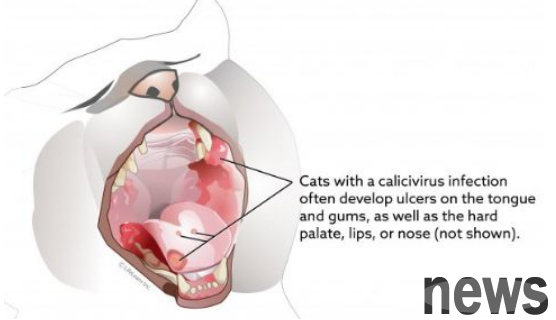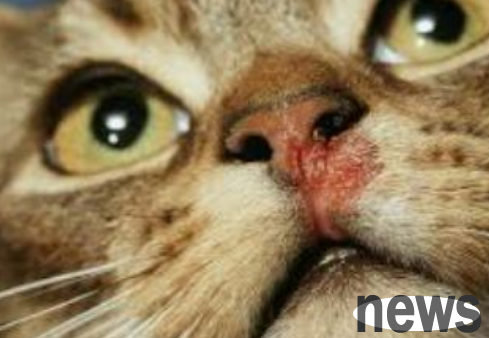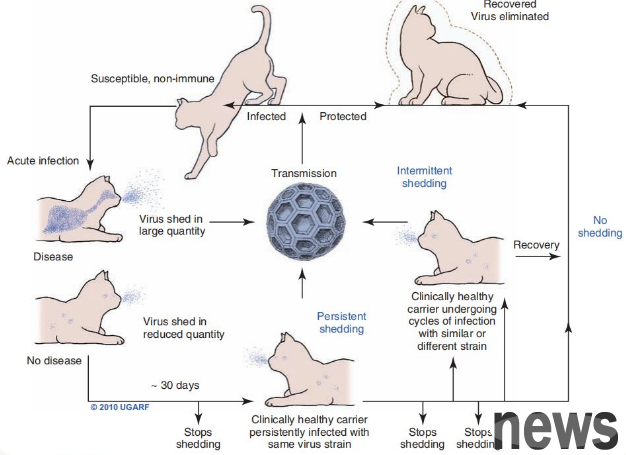The name of cat calicivirus should be familiar to all shovelers. When the cat is vaccinated with Miaosanduo, when the cat has respiratory infections, or when others discuss cat stomatitis, they may have heard of it. But do you really understand it?...
The name of cat calicivirus should be familiar to all shovelers.
When the cat is vaccinated with Miaosanduo, when the cat has respiratory infections, or when others discuss cat stomatitis, they may have heard of it.
But do you really understand it?
What is FCV?
Feline Calicivirus (FCV) is a single-stranded RNA virus with no envelope and spherical capsid (there are multiple cup-shaped depressions on the capsid, which is therefore named). It looks like this:

looks a bit like a hornet's nest, isn't it a little cute?
It is not a simple little cutie!
FCV is highly contagious and can cause acute oral problems and upper respiratory tract diseases. It is one of the most common pathogens of infectious upper respiratory tract diseases in cats (other pathogens include feline herpesvirus-1, FHV-1), mycoplasma, chlamydia and Bordetella, etc.), and even has the risk of inducing stomatitis.
But don't panic first. Although FCV is very contagious, not all cats infected with FCV will have serious clinical symptoms. What are the clinical manifestations of
FCV?
Because cat calicivirus has multiple strains, the virulence of different strains will also vary.
But the most typical and common clinical ulcers are oral or tongue ulcers, and sometimes ulcers may also appear in the nose.

Common ulcer sites
Picture from: vcahospitals
Others: Upper respiratory infections such as drooling, sneezing, eye secretions, coughing, etc. are also common. Some strains may also cause fever, lameness (virus causes synovitis), etc., and long-term invisible infection may induce stomatitis.

FCV cats have nasal ulcers
Most cats infected with FCV have relatively mild clinical manifestations and will not endanger their lives at once. However, malignant systemic calicivirus (VS-FCV) with strong virulence can cause systemic clinical symptoms, such as respiratory distress, jaundice, coagulation disorders, and even cardiac arrest, with a mortality rate of more than 50%. How does
FCV spread?
FCV can be transmitted through droplets, contact with contaminated food basins, licking each other, etc. FCV is more resistant to the environment than herpes virus, and may survive for 28 days in a humid environment.
FCV Epidemiology
After cats are infected with FCV, there is a 2-14-day incubation period. Then there are three situations in different individuals:
(1) The autoimmune mechanism clears the virus: You are the best cat in this gai!
(2) Acute infection status: clinical manifestations become the main source of infection
(3) Asymptomatic virus carrying status: intermittent or continuous detoxification, the invisible source of infection hidden in the cat group may be completely removed one month after treatment or self-recovery, but it may continue to detoxify in the past month, and it may become an asymptomatic poisonous cat again, entering the next cycle.

Picture from: Brad Gilleland © 2010, University of Georgia Research Foundation Inc.
When you get vaccinated, don't worry about cats being infected with FCV?
Some shovelers will think that my cat must be fine, they have been vaccinated regularly, and the antibodies are also qualified.
NO! The protection period of vaccines such as
FHV-1, FCV and other vaccines are relatively short, and there are many species of FCV strains. Although different strains have certain cross-protection, they cannot play a completely preventive role, especially for VS-FCV. Many infected cats are completely immune to cats.
But the vaccine is still effective. Although it cannot prevent infection, it can reduce the degree of incidence.
Which cats are more likely to be infected?
All cats can be infected with FCV, and kittens and cats with immunosuppressive cats are more susceptible to infection.
Since there are multiple strains of FCV, cats who have been vaccinated or recovered from FCV infection cannot obtain lifelong immunity and may re-infection.
What tests are needed to confirm the diagnosis?
Currently, the most sensitive diagnosis method for FCV is to take secretions from a pharyngeal swab for nucleic acid virus testing (PCR), which is similar to the previous test for COVID-19.
If the cat has obvious clinical manifestations, the systemic condition needs to be evaluated through CBC, biochemistry, etc.
FCV=stomatitis?
FCV≠stomatitis≠full mouth tooth extraction!
Above mentioned that some cats can remove all caliciviruses by themselves. It’s not that you will develop stomatitis if you are infected with calicivirus, but there are certain risks. Risk does not mean that you will definitely develop.
Cats with positive cup tests should pay more attention to oral hygiene, brush their teeth frequently, and maintain good oral conditions.
"I OK"
What can we do if the cat detects FCV positive?
✔ If the cat has no clinical manifestations: drug treatment is not necessary. FCV does not have a specific treatment plan, and it clinically supports symptomatic treatment based on the performance of cats.
✔ Multiple cat families: If a cat is in an acute onset period, such as having oral ulcers, sneezing and runny nose, it should be isolated from a healthy cat.
✔ Cats with secretions: clean the secretions of the eyes and nose in time to keep the respiratory tract moist and unobstructed. If you have the conditions, you can use normal saline to atomize for 10-15 minutes every day..
✔ Cats that have been affected by oral pain for a long time: soft food can be given or prevent feeding tubes to ensure sufficient nutritional supply.
✔ Viruses are more likely to survive in low-temperature and humid environments. Pay attention to insulation and keep the room dry and ventilated.
✔ Stress may stimulate the virus to fall off. Cats who are onset or have a history of infection should pay attention to reducing stress. Of course, it is best for all kittens to have a rich and stress-free living environment.